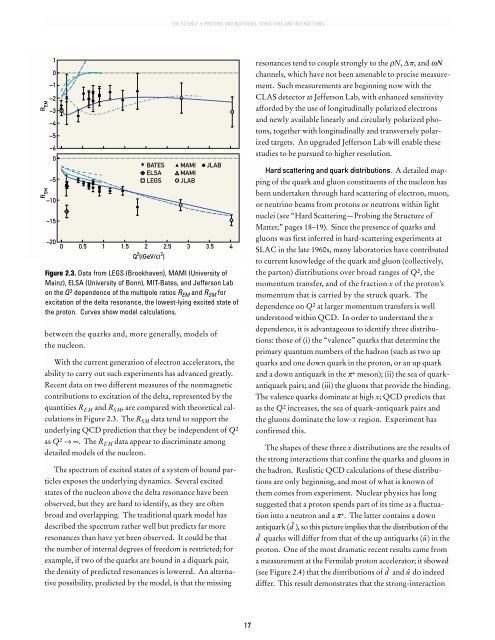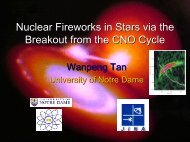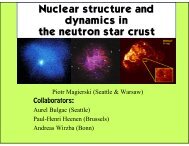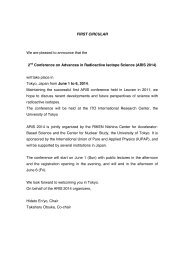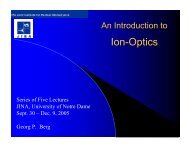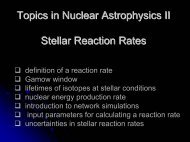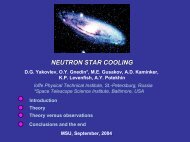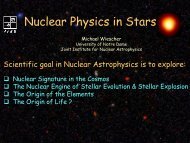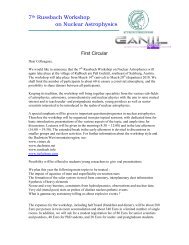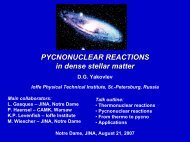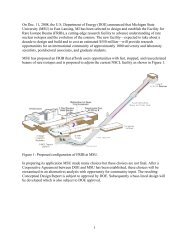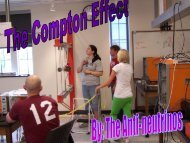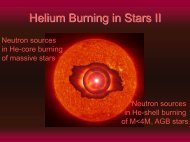OPPORTUNITIES IN NUCLEAR SCIENCE A Long-Range Plan for ...
OPPORTUNITIES IN NUCLEAR SCIENCE A Long-Range Plan for ...
OPPORTUNITIES IN NUCLEAR SCIENCE A Long-Range Plan for ...
Create successful ePaper yourself
Turn your PDF publications into a flip-book with our unique Google optimized e-Paper software.
THE <strong>SCIENCE</strong> • PROTONS AND NEUTRONS: STRUCTURE AND <strong>IN</strong>TERACTIONS<br />
R SM R EM<br />
1<br />
0<br />
– 1<br />
– 2<br />
– 3<br />
– 4<br />
– 5<br />
– 6<br />
0<br />
– 5<br />
– 10<br />
– 15<br />
– 20<br />
0<br />
BATES<br />
ELSA<br />
LEGS<br />
MAMI<br />
MAMI<br />
JLAB<br />
JLAB<br />
0.5 1 1.5 2 2.5 3 3.5 4<br />
Q 2 [(GeV/c) 2 ]<br />
Figure 2.3. Data from LEGS (Brookhaven), MAMI (University of<br />
Mainz), ELSA (University of Bonn), MIT-Bates, and Jefferson Lab<br />
on the Q 2 dependence of the multipole ratios R EM and R SM <strong>for</strong><br />
excitation of the delta resonance, the lowest-lying excited state of<br />
the proton. Curves show model calculations.<br />
between the quarks and, more generally, models of<br />
the nucleon.<br />
With the current generation of electron accelerators, the<br />
ability to carry out such experiments has advanced greatly.<br />
Recent data on two different measures of the nonmagnetic<br />
contributions to excitation of the delta, represented by the<br />
quantities R EM and R SM , are compared with theoretical calculations<br />
in Figure 2.3. The R SM data tend to support the<br />
underlying QCD prediction that they be independent of Q 2<br />
as Q 2 → ∞. The R EM data appear to discriminate among<br />
detailed models of the nucleon.<br />
The spectrum of excited states of a system of bound particles<br />
exposes the underlying dynamics. Several excited<br />
states of the nucleon above the delta resonance have been<br />
observed, but they are hard to identify, as they are often<br />
broad and overlapping. The traditional quark model has<br />
described the spectrum rather well but predicts far more<br />
resonances than have yet been observed. It could be that<br />
the number of internal degrees of freedom is restricted; <strong>for</strong><br />
example, if two of the quarks are bound in a diquark pair,<br />
the density of predicted resonances is lowered. An alternative<br />
possibility, predicted by the model, is that the missing<br />
resonances tend to couple strongly to the ρN, ∆, and ωΝ<br />
channels, which have not been amenable to precise measurement.<br />
Such measurements are beginning now with the<br />
CLAS detector at Jefferson Lab, with enhanced sensitivity<br />
af<strong>for</strong>ded by the use of longitudinally polarized electrons<br />
and newly available linearly and circularly polarized photons,<br />
together with longitudinally and transversely polarized<br />
targets. An upgraded Jefferson Lab will enable these<br />
studies to be pursued to higher resolution.<br />
Hard scattering and quark distributions. A detailed mapping<br />
of the quark and gluon constituents of the nucleon has<br />
been undertaken through hard scattering of electron, muon,<br />
or neutrino beams from protons or neutrons within light<br />
nuclei (see “Hard Scattering—Probing the Structure of<br />
Matter,” pages 18–19). Since the presence of quarks and<br />
gluons was first inferred in hard-scattering experiments at<br />
SLAC in the late 1960s, many laboratories have contributed<br />
to current knowledge of the quark and gluon (collectively,<br />
the parton) distributions over broad ranges of Q 2 , the<br />
momentum transfer, and of the fraction x of the proton’s<br />
momentum that is carried by the struck quark. The<br />
dependence on Q 2 at larger momentum transfers is well<br />
understood within QCD. In order to understand the x<br />
dependence, it is advantageous to identify three distributions:<br />
those of (i) the “valence” quarks that determine the<br />
primary quantum numbers of the hadron (such as two up<br />
quarks and one down quark in the proton, or an up quark<br />
and a down antiquark in the π + meson); (ii) the sea of quarkantiquark<br />
pairs; and (iii) the gluons that provide the binding.<br />
The valence quarks dominate at high x; QCD predicts that<br />
as the Q 2 increases, the sea of quark-antiquark pairs and<br />
the gluons dominate the low-x region. Experiment has<br />
confirmed this.<br />
The shapes of these three x distributions are the results of<br />
the strong interactions that confine the quarks and gluons in<br />
the hadron. Realistic QCD calculations of these distributions<br />
are only beginning, and most of what is known of<br />
them comes from experiment. Nuclear physics has long<br />
suggested that a proton spends part of its time as a fluctuation<br />
into a neutron and a π + . The latter contains a down<br />
antiquark (d - ), so this picture implies that the distribution of the<br />
d - quarks will differ from that of the up antiquarks (ū) in the<br />
proton. One of the most dramatic recent results came from<br />
a measurement at the Fermilab proton accelerator; it showed<br />
(see Figure 2.4) that the distributions of d - and ū do indeed<br />
differ. This result demonstrates that the strong-interaction<br />
17


